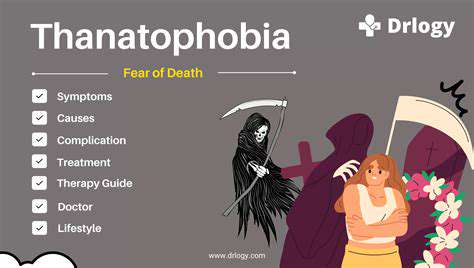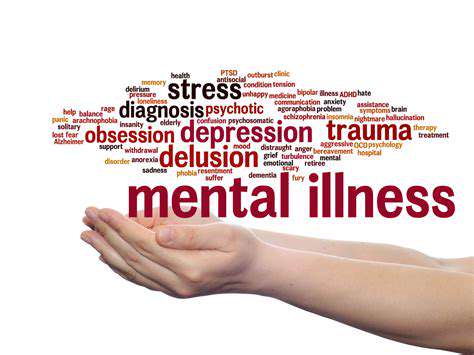Identifying Thanatophobia Symptoms: What You Need to Know
What is Thanatophobia?

Understanding Thanatophobia
Thanatophobia, commonly known as death anxiety, represents a profound psychological condition that transcends age and cultural boundaries. Unlike fleeting worries about mortality, this condition involves an all-consuming dread of death or the dying process that permeates daily existence. The distress it causes can disrupt normal functioning and diminish quality of life in measurable ways.
Clinical research indicates this phobia often stems from multiple intersecting factors rather than a single cause. Personal encounters with loss, particularly traumatic ones, frequently serve as catalysts. Cultural narratives around mortality and frequent exposure to death-related media content may further reinforce these anxieties. Interestingly, existential philosophers have long noted how modern society's discomfort with mortality discussions exacerbates such fears.
Symptoms of Thanatophobia
Manifestations of death anxiety vary considerably in both form and intensity. Physiological responses often mirror panic attacks - think racing pulse, constricted breathing, excessive perspiration, and involuntary tremors. These physical reactions frequently occur alongside intrusive thoughts about mortality.
The psychological toll frequently includes paralyzing dread, cyclical negative thinking patterns, and in severe cases, depressive episodes. Behaviorally, sufferers might avoid hospitals, funerals, or even conversations about aging. Some develop compulsive rituals to ward off death, while others become hypervigilant about health symptoms.
The Impact on Daily Life
This phobia's ripple effects touch nearly every life domain. Social withdrawal becomes common as individuals skip gatherings where death might be discussed. Career trajectories may stall due to avoidance of stressful situations. Even mundane activities like driving or trying new foods can trigger avoidance when perceived as risky.
This self-protective isolation often creates a vicious cycle - the more one avoids death-related stimuli, the more frightening those stimuli become. Over time, this can erode relationships, limit personal development, and create secondary mental health concerns like generalized anxiety.
Treatment Options for Thanatophobia
Contemporary therapeutic approaches offer substantial hope for managing death anxiety. Cognitive Behavioral Therapy helps patients identify and restructure catastrophic thinking patterns about mortality. Through gradual exposure, patients learn to tolerate death-related thoughts without distress.
Emerging research highlights the effectiveness of existential therapies that help patients find meaning despite mortality awareness. While SSRIs may help manage co-occurring anxiety or depression, most clinicians recommend therapy as the primary intervention. Group therapy provides particular value by normalizing these fears through shared experience.
Coping Mechanisms and Self-Care
Daily practices significantly influence symptom management. Diaphragmatic breathing exercises can short-circuit panic responses when death anxiety spikes. Regular physical activity regulates stress hormones while improving sleep quality - both crucial for anxiety management.
Purpose-driven activities create psychological counterweights to mortality fears. Volunteering, creative pursuits, or spiritual practices help shift focus from death's inevitability to life's meaningful possibilities. Maintaining social connections prevents the isolation that often worsens thanatophobia.
The Importance of Professional Help
When death anxiety constricts life significantly, professional guidance becomes essential. Specialized therapists provide evidence-based techniques tailored to individual needs. They create safe spaces to explore mortality fears without judgment.
Early intervention prevents the snowball effect where untreated thanatophobia leads to additional mental health complications. Remember that seeking help demonstrates courage and self-awareness - critical first steps toward reclaiming life from excessive fear.
Recognizing the Physical Symptoms

Recognizing Early Warning Signs
Our bodies communicate through subtle physiological changes that often precede diagnosable conditions. Documenting these bodily signals creates a valuable health record for medical professionals. Persistent exhaustion despite adequate rest, unexplained fluctuations in weight, or alterations in elimination patterns all warrant attention. Skin changes like new moles or rashes may indicate systemic issues needing evaluation.
While these signs don't automatically signal serious illness, they represent the body's early warning system. Tracking their duration, triggers, and accompanying symptoms helps clinicians distinguish between benign variations and potential red flags.
Identifying Common Physical Ailments
Familiarity with typical symptom patterns aids in health monitoring. Headaches demonstrate this principle well - tension types usually involve band-like pressure, while migraines often include light sensitivity and nausea. Chest discomfort might stem from muscle strain, acid reflux, or cardiac issues, with each having distinguishing characteristics. Abdominal pain location and quality (dull vs. sharp) help differentiate between appendicitis, ulcers, or menstrual cramps.
Understanding the Role of Pain
Pain perception involves complex neurobiological processes that vary dramatically between individuals. Acute pain typically follows injury or illness and diminishes with healing, serving a protective function. Chronic pain persists beyond normal tissue healing time, often involving nervous system changes. Cultural background, past experiences, and emotional state all influence how we interpret pain signals.
Assessing Changes in Body Function
Systemic alterations frequently manifest through functional changes. Respiratory modifications like wheezing or shortness of breath may reflect conditions ranging from asthma to pulmonary embolism. Urinary changes could indicate infections, prostate issues, or metabolic disorders. Even subtle shifts like altered handwriting or balance problems might signal neurological changes requiring evaluation.
Evaluating Changes in Appearance
The body's exterior often mirrors internal health status. Skin serves as a particularly revealing organ - jaundice suggests liver dysfunction, while pallor may indicate anemia. Sudden hair thinning could reflect nutritional deficiencies or hormonal imbalances. Nail abnormalities like clubbing or discoloration sometimes correlate with pulmonary or circulatory conditions. These visible changes frequently precede other symptoms, making them valuable diagnostic clues.
Analyzing Sensory Disturbances
Sensory systems provide critical health information when functioning properly. Visual changes like floaters, flashes, or blurred vision demand prompt ophthalmological assessment. Hearing alterations, whether sudden deafness or tinnitus, may stem from acoustic trauma or neurological issues. Peripheral numbness or tingling could indicate nerve compression or metabolic disorders like diabetes. These symptoms frequently represent the first noticeable signs of developing conditions.
Differentiating Normal Variations from Serious Symptoms
Contextual understanding helps separate concerning symptoms from benign variations. Transient muscle soreness after exercise differs significantly from unexplained joint pain persisting weeks. Occasional heart palpitations during stress contrast with persistent irregular rhythms accompanied by dizziness. Fatigue following poor sleep differs from overwhelming exhaustion despite adequate rest. Recognizing these distinctions prevents both unnecessary worry and dangerous symptom minimization.